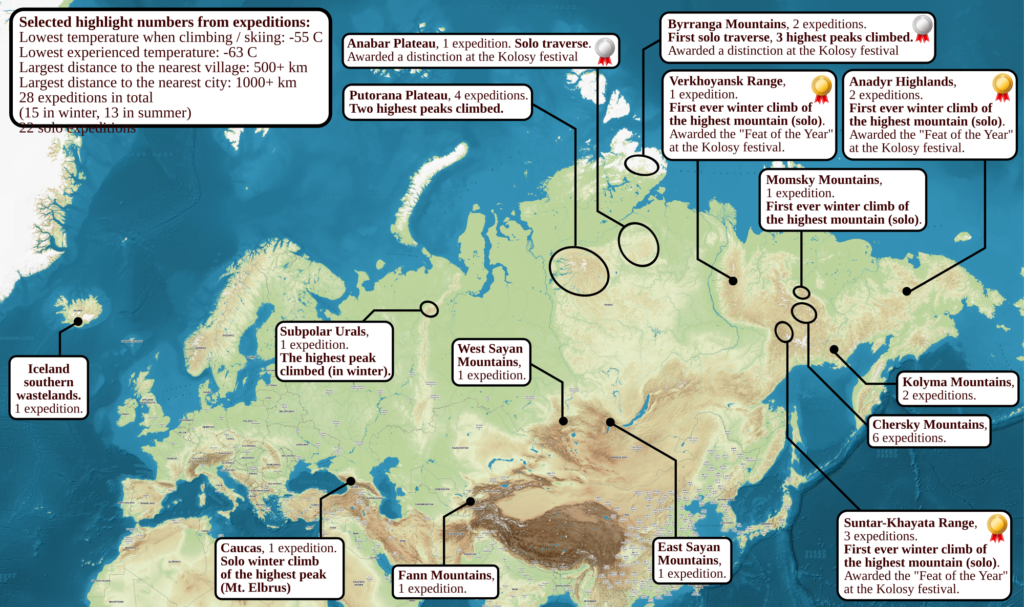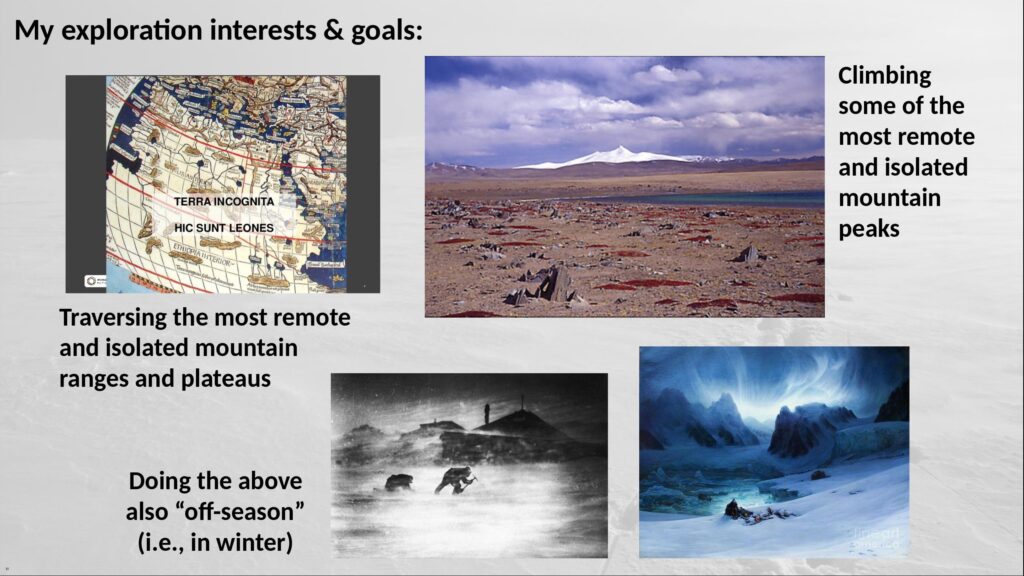Executive Summary This website is dedicated to something I call exploratory mountaineering: climbing mountains and traversing ranges and plateaus, often high in the Arctic, with two special properties: as cold as possible and/or as remote and hard-to-get as possible. The name of the website, “Exploratio Incognita”, means in Latin “The Exploration of the Unknown”.
About me Personally, I am a scientist at ETH Zurich, specializing in what is best described by “Understanding and accelerating irregular computations”. This is an area that sits on the overlap of high-performance computing, large-scale data analysis and data science, graph theory, interconnection networks, algorithms and data structures, high-performance architectures, and several others. If you are interested, a link to my personal research focused website is at the bottom of this page. Simultaneously, since the age of 20, I have been regularly organizing mountaineering expeditions (almost always solo) to remote, uninhabited, usually cold, and logistically demanding mountain ranges and plateaus, in all seasons, with special focus on the mountains of Siberia and Siberian Arctic (located in regions such as Yakutia, Taimyr, Kolyma, Chukotka, Central Siberian Plateau, and other Russian republics and regions). I conduct expeditions because I like to solve challenging multifaceted problems in exploratory mountaineering and in polar exploration in very remote and hard-to-reach mountain ranges and plateaus. Moreover, I use expeditions as a propeller for more effective and more efficient research activities.
Profile of expeditions I am most interested in: (1) climbing very remote peaks in deep winter conditions in January – February (usually previously unclimbed in winter – first winter ascents), focusing on the coldest parts of Siberia (2) traversing extremely isolated mountain ranges and large plateaus and climbing the highest peaks of these ranges, and (3) photography, focusing on expressing the isolation and remoteness of the visited mountains.
Where exactly? As my targets, I select mountains and plateaus that are as remote and isolated from nearest civilization outposts as possible, extremely hard to get to and explore, very challenging logistically and topographically, and mostly unexplored (having seen little to no exploratory attention). An example is Byrranga Mountains, an absolutely pristine and equally harsh mountain range in the Russian Arctic located more than 500km from the nearest reachable village, where I organized solo expeditions. Another example are various Yakutian mountain ranges in winter: very far away from civilization, and unique due to their extremely low winter temperatures, reaching levels below -70 Celsius.
Why? (a general statement of reason) The foremost obvious reason is the exploration of the unknown, virgin, and challenging mountain territories. Besides the purely exploratory aspect, I strongly believe that my expeditions facilitate the development of personality strength, mental endurance, perseverance and tenacity, resistance to stress, and leadership skills. They have positively contributed to many of my research activities: all the mental and psychological resources developed and trained in very hostile environments can be directly reused when tackling demanding deadlines and any other research challenges. The expeditions are also a great lesson in efficient risk management and decision making: one must learn how to quickly and efficiently make many decisions that may immediately either endanger or save one’s life.
Why the mountains of North Siberia and Siberian Arctic specifically? Because this is an extremely hostile and unyielding environment, very challenging, virtually unexplored, and completely pristine in most parts. Both summers and winters come with numerous mental and physical challenges related to weather, climate, terrain, for example:
- Deep valleys full of swampy and impassable taiga forests,
- Vast, gloomy, and severe plateaus with ferocious winds,
- Unexplored crevassed glaciers,
- Violent and wide rivers,
- Grey and bleak polar deserts,
- Endless marshy tundra,
- Sheer cliffs and deep canyons,
- Technically demanding mountain ridges and faces,
- Temperatures as low as -70 C (without the windchill factor) and as high as +40 C,
- Deep, soft, and unstable snow,
- Vast fields of sharp stones,
- Wild animals,
- Ultimate isolation and solitude,
- Many others.
>>> Check out the best photos here.
>>> Check all expeditions here.
Selected explored mountains and plateaus:

All expeditions are unsupported – I always organize and manage the logistics of the route myself, and do not use any form of external help during expeditions, besides the necessary local transportation (e.g., snow mobiles when approaching selected mountain massifs during expeditions that focus on climbing).
The maximized metrics in my expeditions are: (1) the isolation and the distance from nearest civilization outposts (and thus indirectly logistics and transportation challenges) as well as (2) the severity of weather and climate.

I collaborate with many companies:
>>> Check the partnership subsite for more information.
>>> You may also take a look at the equipment tests and recommendation.
Some of the most interesting expeditions so far are:
- The first winter ascent (solo, early January) of Mus-Khaya, arguably “the coldest mountain of the northern Hemisphere” – the highest peak of the Suntar-Khayata range, one of the main mountain ranges of Yakutia, located in the Oymyakon District, where Oymyakon, a village referred to as “the Pole of Cold”, is situated. Temperatures down to -55 Celsius.
- The first winter ascent (solo, mid February) of another pretender to the title of “the coldest mountain of the northern Hemisphere” – the highest peak of the Verkhoyansk range, one of the main mountain ranges of Yakutia, located nearby Verkhoyansk, another village referred to as “the Pole of Cold”.
- The first traverse (solo) of the highest part of Byrranga Mountains, the northernmost continental mountain range (with climbing all highest peaks) located in the northernmost Siberian Arctic (these mountains are described in research papers as one of the most remote and least studied areas of the whole Arctic).
- A solo winter climb of Mt. Elbrus, the highest peak in Europe (done in a very fast style; the whole expedition took 2.5 days);
- The first winter ascent (solo, late January) of the highest peak (unnamed) in Momsky Mountains (a remote mountain range in Yakutia), with temperatures down to -55 Celsius;
- A “Marriage Expedition” – hitchhiking in winter conditions, on frozen rivers and across mountain passes (together with my fiancee) to deep taiga in Yakutia, getting married (a legally valid Catholic ceremony) at the bottom of the breath-taking Chersky Mountains, and having a memorable party with our befriended herders of reindeers;
- The first Polish winter ascent of Mount Narodnaya, the highest peak in the Ural Mountains.
>>> Check all these expeditions, and many others, here.
A never-ending source of inspiration and examples are the lives of the exploration giants, such as Fridtjof Nansen, Roald Amundsen, Ernest Shackleton, Richard Francis Burton, Wojciech Kurtyka, Reinhold Messner, Walter Bonatti, Jerzy Kukuczka, Naomi Uemura, Willem Barentsz, Semyon Chelyuskin, Sven Hedin, Henry Hudson, Valerian Albanov, Jan Czerski, and many others
>>> Click here if you want to check out my research website <<<

Omnipotens Deus: Ego coram te quaerere, eaque omnia pro auxilio ac patrocinio assequamur. Da mihi faciat propter magnam gloriam tuam.